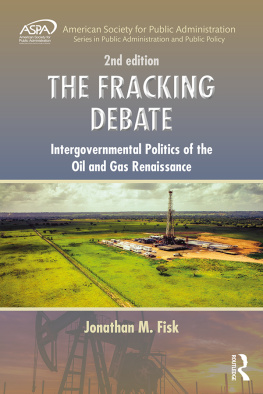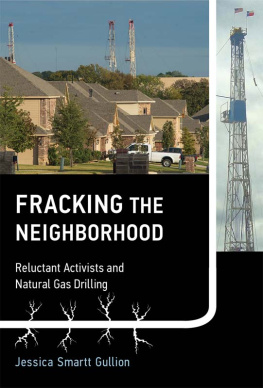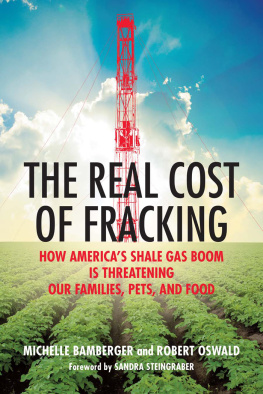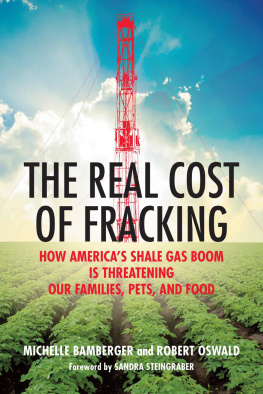HYDROFRACKING
WHAT EVERYONE NEEDS TO KNOW
HYDROFRACKING
WHAT EVERYONE NEEDS TO KNOW
ALEX PRUDHOMME


Oxford University Press is a department of the University of Oxford.
It furthers the Universitys objective of excellence in research, scholarship,
and education by publishing worldwide.
Oxford New York
Auckland Cape Town Dar es Salaam Hong Kong Karachi
Kuala Lumpur Madrid Melbourne Mexico City Nairobi
New Delhi Shanghai Taipei Toronto
With offices in
Argentina Austria Brazil Chile Czech Republic France Greece
Guatemala Hungary Italy Japan Poland Portugal Singapore
South Korea Switzerland Thailand Turkey Ukraine Vietnam
Oxford is a registered trademark of Oxford University Press
in the UK and certain other countries.
What Everyone Needs to Know is a registered trademark of Oxford
University Press.
Published in the United States of America by
Oxford University Press
198 Madison Avenue, New York, NY 10016
Alex Prudhomme 2014
All rights reserved. No part of this publication may be reproduced, stored in a retrieval system, or transmitted, in any form or by any means, without the prior permission in writing of Oxford University Press, or as expressly permitted by law, by license, or under terms agreed with the appropriate reproduction rights organization. Inquiries concerning reproduction outside the scope of the above should be sent to the Rights Department, Oxford University Press, at the address above.
You must not circulate this work in any other form
and you must impose this same condition on any acquirer.
Library of Congress Cataloging-in-Publication Data
Prudhomme, Alex.
Hydrofracking / Alex Prudhomme.
pages cm(What everyone needs to know)
Includes bibliographical references and index.
ISBN 9780199311255 (pbk. : alk. paper)ISBN 9780199311262
(cloth : alk. paper) 1. Hydraulic fracturingPopular works.
2. Shale gas reservoirsPopular works. 3. Oil wells
Hydraulic fracturingPopular works. I. Title.
TN880.2.P78 2013
622.3383dc23
2013028962
1 3 5 7 9 8 6 4 2
Printed in the United States of America
on acid-free paper
CONTENTS
acid. A generic term used to describe a treatment fluid typically comprising hydrochloric acid and a blend of acid additives.
annulus. The space between a casing string and the borehole or between two casing strings.
aquifer. A water-bearing stratum of permeable rock, sand, or gravel.
biocide. An additive that eliminates bacteria in the water that produce corrosive byproducts.
blender. The equipment used to prepare the slurries and gels commonly used in fracture stimulation treatments.
borehole. A hole drilled into the earth by people in search of natural gas and oil.
breaker. An additive that reduces the viscosity of fluids by breaking long-chain molecules into shorter segments.
CAS. Chemical Abstract Service, a division of the American Chemical Society, whose objective is to find, collect, and organize publicly disclosed substance information.
CAS number. A unique number assigned by the CAS that identifies a chemical substance or molecular structure.
The List compiled from FracFocus: http://fracfocus.org/glossary of terms, and the State of California, Department of Conservation website: http://www.conservation.ca.gov/index/Pages/glossary-frk.aspx
casing. Pipe placed in an oil or gas well to (1) prevent the wall of the hole from caving in; (2) prevent movement of fluids from one geologic formation to another; (3) provide a means of maintaining control of formation fluids and pressure as the well is drilled.
casing string. Pipe that lines a well after it has been drilled. It is formed from sections of tube that have been screwed together.
collapse strength of casing. The pressure necessary to collapse a well casing, tubing, or drill pipe inside a well. The collapse strength of casing can be calculated from the yield strength of the metal and diameter of and wall thickness of the casing, tubing, or drill pipe.
conductor casing. Generally, the first string of casing in a well. It may be lowered into a hole drilled into the formations near the surface and cemented in place, or it may be driven into the ground by a special pile driver. Its purpose is to prevent the soft formations near the surface from caving in and to conduct drilling mud from the bottom of the hole to the surface when drilling starts. (Also known as conductor pipe and drive pipe.)
casing shoe. A tapered, bullet-nosed piece of equipment often found on the bottom of a casing string. The device guides the casing toward the center of the borehole and minimizes problems associated with hitting rock ledges or washouts as the casing is lowered into the well. (Also known as a guide shoe.)
cement. A mixture of sand, water, and a binding agent with no aggregates.
Cement Bond Log. A geophysical log that graphically displays the bond between cement and casing.
clay stabilizer. An additive that prevents clays from swelling or shifting.
conductor casing. The first casing string placed in a borehole. The purpose of the conductor is to prevent the collapse of the hole in unconsolidated material, such as soil.
corrosion inhibitor. An additive used in acid treatments to prevent corrosion of pipe by the corrosive treating fluid.
cross-linker. An additive that reacts with multiple-strand polymers to couple molecules, creating a fluid of high but closely controlled viscosity.
Darcys Law. The mathematical equation that quantifies the ability of fluid to flow through porous material such as rock.
data van. The truck used to monitor all aspects of the hydraulic fracturing job.
DOE. The US Department of Energy.
drilling rig. The equipment used to drill the borehole.
EPA. The US Environmental Protection Agency.
EPCRA. The Emergency Planning and Community Right to Know Act. In 1986, Congress enacted EPCRA, a statute that established requirements for federal, state, and local governments, tribes, and industry regarding emergency planning and community right-to-know reporting on hazardous and toxic chemicals. One provision of EPCRA remains highly controversial. As the EPA notes, All information submitted pursuant to EPCRA regulations is publicly accessible, unless protected by a trade secret claim.
frac tank. The container used to store water or proppant that will be used for hydraulic fracturing.
friction reducer. An additive used to reduce the friction forces on tools and pipes in the borehole.
gelling agent. An additive that increases the viscosity of a fluid without substantially modifying its other properties.
groundwater. Water in a saturated zone under the earths surface.
GWPC. Ground Water Protection Council.
hydrology. The study of the flow of water.
intermediate casing. Provides protection against caving in of weak or abnormally pressured formations and enables the use of drilling fluids used to drill into lower formations.
Next page












